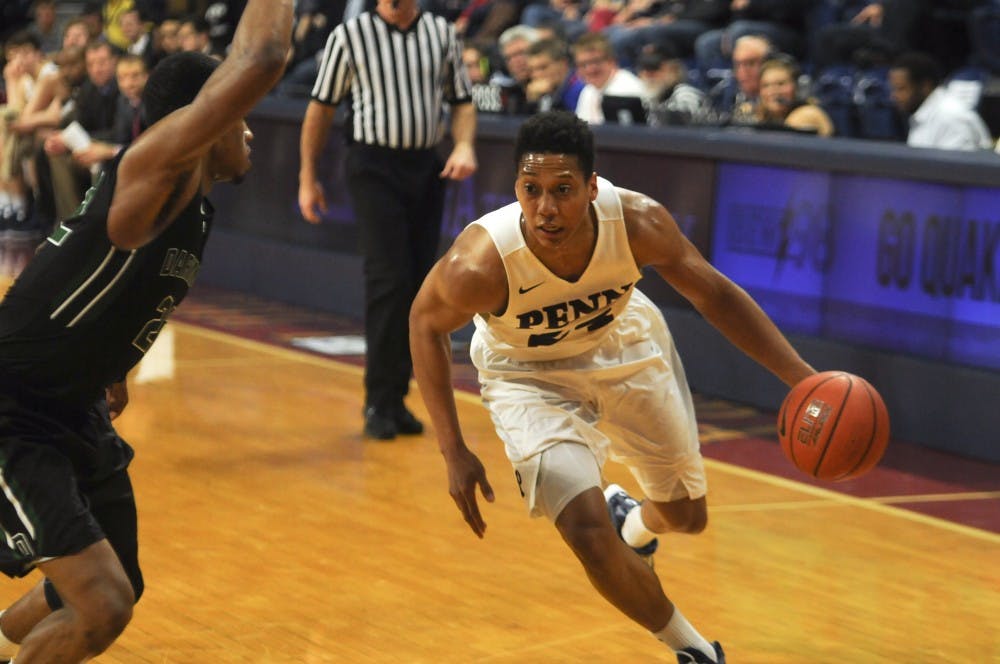When Penn men’s basketball coach Steve Donahue inherited an offense that averaged a mere 60.3 points per game in 2014-15 — the school’s lowest output since Sports Reference began recording college basketball in 1994 — it was clear that changes had to be made.
Needless to say, forward Matt Howard got the message.
Boasting career-bests in nearly every statistical category imaginable, the 6-foot-4 junior has seized a central role for Penn, leading a team that has already surpassed last season’s win total in both conference play and the regular season as a whole.
“Did I expect [myself taking a primary offensive role] to happen this quickly? Probably not,” Howard said. “But I’m up to it, I see it as a challenge and I have to just keep grinding and doing my thing.”
Usage and efficiency are supposed to be inversely related traits in basketball, but Howard has completely bucked that narrative this season.
Whether looking at commonly-used numbers such as points per game (Howard averages 12.4), rebounds per game (5.8) and field goal percentage (0.483) or more complex statistics like true shooting percentage (0.571), offensive rating (110.4) and player efficiency rating (17.2), Howard has left his prior self in the dust, becoming one of Penn’s most reliable players despite a career-high offensive usage rate of 20.8 percent.
“I think it’s been a combination of physical and mental improvement,” he said. “I’ve just gotten a lot more comfortable with the game at the collegiate level, I’m a lot stronger and faster, and having Coach Donahue’s offense has paid off.”
Howard isn’t the only figure to benefit from Donahue’s new system, as the Quakers’ scoring average of 68.8 points per game is their highest since 2007 — the last time the program qualified for the NCAA Tournament.
But with Donahue’s strategy being so heavily predicated on the long ball, there were questions about how Howard, who had only attempted a total of 55 three-pointers in his first two seasons, would be able to adjust.
The solution? A “small-ball” starting lineup, with three-point specialist Sam Jones and Howard playing at the two forward positions complementing 6-foot-11 center Darien Nelson-Henry inside.
“Before the season, I knew there were going to be a lot more three-point attempts on my end, so I was just putting in that extra work over the summer and getting up a lot of shots,” Howard said. “Moving to the 4 from the 3 was a little difficult on the defensive end at first, but it definitely gave me an advantage on the offensive side.”
Although an increase in Howard’s three-point attempts hasn’t necessarily resulted in more success — Howard’s three-point percentage is actually a career-low 0.288 in 2015-16 — his overall transformation has allowed him to become a threat from all over the floor.
“When we started working out, I just thought he would be an ideal 4-man in this system because he’s probably our most athletic player. He’s versatile enough to guard bigger guys and quicker guys, and then on the offensive end he’s a hard guard,” Donahue said. “He’s been inconsistent with his three-point shooting, but I think you’re still seeing someone that teams can’t leave open, and you can see improvement in every other aspect of his game.”
Following the departure of point guard Antonio Woods, Howard’s newfound aggressiveness has become even more necessary, and the junior has responded strongly. At a remarkable 63.8 percent clip from inside the three-point arc, he’s the best shooter in the Ivy League from that range among players averaging at least 10 points per game.
“The thing that would probably hold him back is just his personality and willingness to let someone else do it, but what we’ve seen these last few weeks is his aggressiveness in attacking the rim,” Donahue said. “I never outright said, ‘Take over’ — we generally don’t coach that way on offense — but he’s probably the one guy on our team who can go get his own.”
When combining Howard’s ability to get to the basket with the presence of two of the league’s top ten three-point shooters in Jones and Jackson Donahue and a dominant post presence in Nelson-Henry, the potential offensive benefits are endless.
“He provides a really good complement, because we can’t have everybody be post-up players or shooters,” Steve Donahue said. “I think Matt does add a little different dimension, and that’s a big help to the other guys.”
Ultimately, to call Howard’s season a career year would be an understatement — but there’s still room for more. With four starters returning from a team that has already risen three spots in the conference ranks from last season, the sky is the limit for what Howard can accomplish in his final year donning the Red and Blue.
“We’re really going to stress working on his ball-handling, working him to be a better fundamental catch-and-shoot guy, increasing his flexibility, and really just playing fast,” Steve Donahue said. “I think if he continues to do the things he does on defense and just build on the experience he got this year, he could be one of the best players in the Ivy League.”









